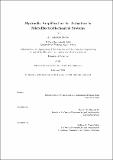| dc.contributor.advisor | Nesbitt W. Hagood, IV. | en_US |
| dc.contributor.author | Steyn, J. Lodewyk (Jasper Lodewyk), 1976- | en_US |
| dc.contributor.other | Massachusetts Institute of Technology. Dept. of Aeronautics and Astronautics. | en_US |
| dc.date.accessioned | 2005-05-19T14:57:36Z | |
| dc.date.available | 2005-05-19T14:57:36Z | |
| dc.date.copyright | 2002 | en_US |
| dc.date.issued | 2002 | en_US |
| dc.identifier.uri | http://hdl.handle.net/1721.1/16834 | |
| dc.description | Thesis (S.M.)--Massachusetts Institute of Technology, Dept. of Aeronautics and Astronautics, 2002. | en_US |
| dc.description | Includes bibliographical references (p. [121]-123). | en_US |
| dc.description | This electronic version was submitted by the student author. The certified thesis is available in the Institute Archives and Special Collections. | en_US |
| dc.description.abstract | In this work the concept of hydraulic amplification as a means of stroke amplification is explored for applications in MicroElectroMechanical Systems (MEMS). Building on the batch fabrication technologies of the semiconductor industry, MEMS technology could enable the simultaneous fabrication of multiple microhydraulic systems of which hydraulic amplifiers would form part. Precision lithography would furthermore make dense arrays of microhydraulic systems possible, with the eventual goal being to create high power density microscale actuation and power generation systems. This document provides an overview of the design considerations required for a successful microfabricated hydraulic amplifier, and proceeds to discuss the techniques developed to successfully fabricate, assemble and test such a device. Deep Reactive Ion Etching (DRIE) techniques were developed for creating strong tethered membrane structures using Silicon On Insulator (SOI) technology. Bonding techniques included silicon-silicon fusion bonding of fragile wafers and silicon-glass anodic bonding and alignment on the wafer and die level to produce multi-layered structures. Liquid filling of micromachined dead volumes through micron-size channels was performed. Static sealing techniques for leak-free sealing of micromachined, filled dead volumes with minimal seal compression and dynamic sealing techniques when quasi-static actuation is not a prerequisite were successfully developed. Using these techniques, several hydraulic amplification devices have been produced. Testing of these devices revealed good correlation with theoretical predictions. Stroke amplification ratios as high as 48 : 1 have been observed. In addition, natural frequencies of up to 10kHz were measured. In conclusion, this work verifies the viability of hydraulic amplification for applications in microscale actuation systems. | en_US |
| dc.description.statementofresponsibility | by J. Lodewyk Steyn. | en_US |
| dc.format.extent | 218 p. | en_US |
| dc.format.extent | 7468386 bytes | |
| dc.format.extent | 7468201 bytes | |
| dc.format.mimetype | application/pdf | |
| dc.format.mimetype | application/pdf | |
| dc.language.iso | eng | en_US |
| dc.publisher | Massachusetts Institute of Technology | en_US |
| dc.rights | M.I.T. theses are protected by copyright. They may be viewed from this source for any purpose, but reproduction or distribution in any format is prohibited without written permission. See provided URL for inquiries about permission. | en_US |
| dc.rights.uri | http://dspace.mit.edu/handle/1721.1/7582 | |
| dc.subject | Aeronautics and Astronautics. | en_US |
| dc.title | Hydraulic amplification for actuation in microelectromechanical systems | en_US |
| dc.title.alternative | Hydraulic amplification for actuation in MEMS | en_US |
| dc.type | Thesis | en_US |
| dc.description.degree | S.M. | en_US |
| dc.contributor.department | Massachusetts Institute of Technology. Department of Aeronautics and Astronautics | |
| dc.identifier.oclc | 51277853 | en_US |
